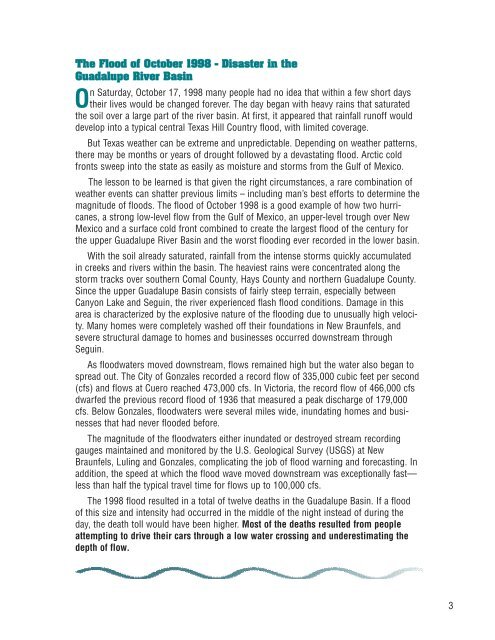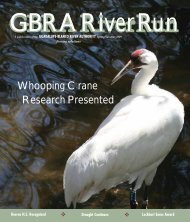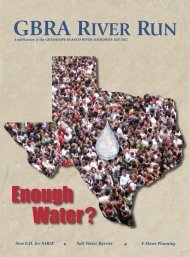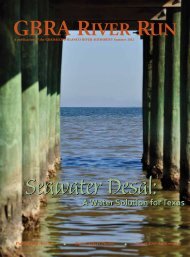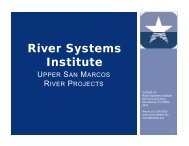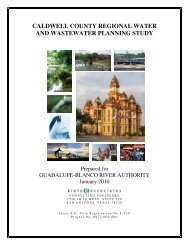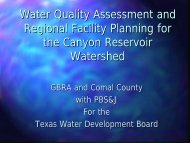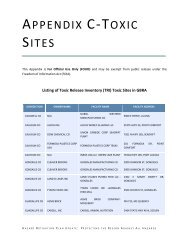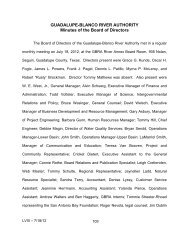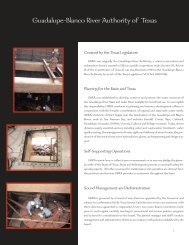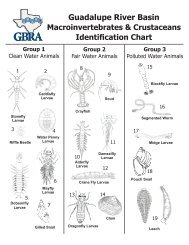Staying Safe Flood Guide - Guadalupe-Blanco River Authority
Staying Safe Flood Guide - Guadalupe-Blanco River Authority
Staying Safe Flood Guide - Guadalupe-Blanco River Authority
You also want an ePaper? Increase the reach of your titles
YUMPU automatically turns print PDFs into web optimized ePapers that Google loves.
The <strong>Flood</strong> of October 1998 - Disaster in the<br />
<strong>Guadalupe</strong> <strong>River</strong> Basin<br />
On Saturday, October 17, 1998 many people had no idea that within a few short days<br />
their lives would be changed forever. The day began with heavy rains that saturated<br />
the soil over a large part of the river basin. At first, it appeared that rainfall runoff would<br />
develop into a typical central Texas Hill Country flood, with limited coverage.<br />
But Texas weather can be extreme and unpredictable. Depending on weather patterns,<br />
there may be months or years of drought followed by a devastating flood. Arctic cold<br />
fronts sweep into the state as easily as moisture and storms from the Gulf of Mexico.<br />
The lesson to be learned is that given the right circumstances, a rare combination of<br />
weather events can shatter previous limits – including man’s best efforts to determine the<br />
magnitude of floods. The flood of October 1998 is a good example of how two hurricanes,<br />
a strong low-level flow from the Gulf of Mexico, an upper-level trough over New<br />
Mexico and a surface cold front combined to create the largest flood of the century for<br />
the upper <strong>Guadalupe</strong> <strong>River</strong> Basin and the worst flooding ever recorded in the lower basin.<br />
With the soil already saturated, rainfall from the intense storms quickly accumulated<br />
in creeks and rivers within the basin. The heaviest rains were concentrated along the<br />
storm tracks over southern Comal County, Hays County and northern <strong>Guadalupe</strong> County.<br />
Since the upper <strong>Guadalupe</strong> Basin consists of fairly steep terrain, especially between<br />
Canyon Lake and Seguin, the river experienced flash flood conditions. Damage in this<br />
area is characterized by the explosive nature of the flooding due to unusually high velocity.<br />
Many homes were completely washed off their foundations in New Braunfels, and<br />
severe structural damage to homes and businesses occurred downstream through<br />
Seguin.<br />
As floodwaters moved downstream, flows remained high but the water also began to<br />
spread out. The City of Gonzales recorded a record flow of 335,000 cubic feet per second<br />
(cfs) and flows at Cuero reached 473,000 cfs. In Victoria, the record flow of 466,000 cfs<br />
dwarfed the previous record flood of 1936 that measured a peak discharge of 179,000<br />
cfs. Below Gonzales, floodwaters were several miles wide, inundating homes and businesses<br />
that had never flooded before.<br />
The magnitude of the floodwaters either inundated or destroyed stream recording<br />
gauges maintained and monitored by the U.S. Geological Survey (USGS) at New<br />
Braunfels, Luling and Gonzales, complicating the job of flood warning and forecasting. In<br />
addition, the speed at which the flood wave moved downstream was exceptionally fast—<br />
less than half the typical travel time for flows up to 100,000 cfs.<br />
The 1998 flood resulted in a total of twelve deaths in the <strong>Guadalupe</strong> Basin. If a flood<br />
of this size and intensity had occurred in the middle of the night instead of during the<br />
day, the death toll would have been higher. Most of the deaths resulted from people<br />
attempting to drive their cars through a low water crossing and underestimating the<br />
depth of flow.<br />
3


